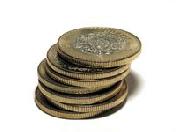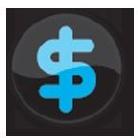
 |
|
| Financial Terms | |
| Fixed-dollar obligations |
|
Information about financial, finance, business, accounting, payroll, inventory, investment, money, inventory control, stock trading, financial advisor, tax advisor, credit.
Main Page: financial, accounting, inventory control, finance, stock trading, business, money, financial advisor, |
Definition of Fixed-dollar obligations
Fixed-dollar obligationsConventional bonds for which the coupon rate is set as a fixed percentage of the par value.
Related Terms:Dollar bondsMunicipal revenue bonds for which quotes are given in dollar prices. Not to be confused with Dollar durationThe product of modified duration and the initial price. Dollar price of a bondPercentage of face value at which a bond is quoted. Dollar returnThe return realized on a portfolio for any evaluation period, including (1) the change in market Dollar rollSimilar to the reverse repurchase agreement - a simultaneous agreement to sell a security held in a Dollar safety marginThe dollar equivalent of the safety cushion for a portfolio in a contingent immunization Dollar-weighted rate of returnAlso called the internal rate of return, the interest rate that will make the  EurodollarThis is an American dollar that has been deposited in a European bank or an U.S. bank branch Eurodollar bondsEurobonds denominated in U.S.dollars. Fixed assetLong-lived property owned by a firm that is used by a firm in the production of its income. Fixed asset turnover ratioThe ratio of sales to fixed assets. Fixed costA cost that is fixed in total for a given period of time and for given production levels. Fixed-annuitiesAnnuity contracts in which the insurance company or issuing financial institution pays a Fixed-charge coverage ratioA measure of a firm's ability to meet its fixed-charge obligations: the ratio of Fixed-datesIn the Euromarket the standard periods for which Euros are traded (1 month out to a year out) are Fixed-dollar securityA nonnegotiable debt security that can be redeemed at some fixed price or according to  Fixed-exchange rateA country's decision to tie the value of its currency to another country's currency, gold Fixed-income equivalentAlso called a busted convertible, a convertible security that is trading like a straight Fixed-income instrumentsAssets that pay a fixed-dollar amount, such as bonds and preferred stock. Fixed-income marketThe market for trading bonds and preferred stock. Fixed price basisAn offering of securities at a fixed price. Fixed-price tender offerA one-time offer to purchase a stated number of shares at a stated fixed price, Fixed-rate loanA loan on which the rate paid by the borrower is fixed for the life of the loan. Fixed-rate payerIn an interest rate swap the counterparty who pays a fixed rate, usually in exchange for a Full faith-and-credit obligationsThe security pledges for larger municipal bond issuers, such as states and Soft dollarsThe value of research services that brokerage houses supply to investment managers "free of Total dollar returnThe dollar return on a nondollar investment, which includes the sum of any Fixed assetsThings that the business owns and are part of the business infrastructure – fixed assets may be Fixed costsCosts that do not change with increases or decreases in the volume of goods or services Intangible fixed assetsNon-physical assets, e.g. customer goodwill or intellectual property (patents and trademarks). Semi-fixed costs Costs that are constant within a defined level of activity but that can increase or decrease when Tangible fixed assetsPhysical assets that can be seen and touched, e.g. buildings, machinery, vehicles, computers etc. fixed assetsAn informal term that refers to the variety of long-term operating fixed expenses (costs)Expenses or costs that remain the same in amount, Fixed Assets Turnover RatioA measure of the utilization of a company's fixed assets to Fixed Charge Coverage RatioA measure of how well a company is able to meet its fixed dollar days (of inventory)a measurement of the value of inventory for the time that inventory is held fixed costa cost that remains constant in total within a specified fixed overhead spending variancethe difference between the total actual fixed overhead and budgeted fixed overhead; fixed overhead volume variancesee volume variance Fixed-income securityA security that pays a specified cash flow over a Constant dollar accountingA method for restating financial statements by reducing or Fixed assetAn item with a longevity greater than one year, and which exceeds a company’s Fixed costA cost that does not vary in the short run, irrespective of changes in any Fixed overheadThat portion of total overhead costs which remains constant in size eurodollarsdollars held on deposit in a bank outside the United States. fixed costsCosts that do not depend on the level of output. Constant dollarsSee real dollars. Current DollarsA variable like GDP is measured in current dollars if each year's value is measured in prices prevailing during that year. In contrast, when measured in real or constant dollars, each year's value is measured in a base year's prices. EurodollarsDeposits denominated in U.S. dollars but held in banks located outside the United States, such as in Canada or France. Fixed Exchange RateAn exchange rate held constant by a government promise to buy or sell dollars at the fixed rate on the foreign exchange market. Fixed-location storageAn inventory storage technique under which permanent Dollar Cost AveragingA way of smoothing out your investment deposits by investing regularly. Instead of making one large deposit a year into your RRSP, you make smaller regular monthly deposits. If you are buying units in a mutual fund or segregated equity fund, you would end up buying more units in the month that values were low and less units in the month that values were higher. By spreading out your purchases, you don't have to worry about buying at the right time. Split Dollar Life InsuranceThe split dollar concept is usually associated with cash value life insurance where there is a death benefit and an accumulation of cash value. The basic premise is the sharing of the costs and benefits of a life insurance policy by two or more parties. Usually one party owns and pays for the insurance protection and the other owns and pays for the cash accumulation. There is no single way to structure a split dollar arrangement. The possible structures are limited only by the imagination of the parties involved. Fixed AssetsLand, buildings, plant, equipment, and other assets acquired for carrying on the business of a company with a life exceeding one year. Normally expressed in financial accounts at cost, less accumulated depreciation. Fixed ExpensesCost of doing business which does not change with the volume of business. Examples might be rent for business premises, insurance payments, heat and light. Fixed Interest RateA rate that does not fluctuate with general market conditions. Fixed Rate LoanLoan for a fixed period of time with a fixed interest rate for the life of the loan. Longer-Term Fixed AssetsAssets having a useful life greater than one year but the duration of the 'long term' will vary with the context in which the term is applied. Related to : financial, finance, business, accounting, payroll, inventory, investment, money, inventory control, stock trading, financial advisor, tax advisor, credit. |